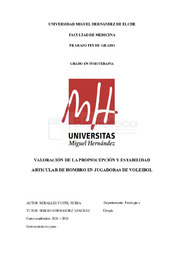Resumen :
INTRODUCCIÓN
El hombro es la articulación más móvil del cuerpo, lo que la convierte en una de las más
vulnerables a lesiones, especialmente en deportes con gestos por encima de la cabeza como en el
voleibol. Esto hace que sea la más inestable, por lo que se requiere una coordinación entre
movilidad, fuerza y control neuromuscular para mantener su funcionalidad. En el voleibol, este
equilibrio es clave para prevenir lesiones y mantener el rendimiento deportivo.
OBJETIVO
Analizar la relación entre la propiocepción, estabilidad en cadena cinética cerrada y función
percibida del hombro en jugadoras universitarias de voleibol.
MATERIAL Y MÉTODOS
Se realizó un estudio observacional transversal con 14 jugadoras universitarias de voleibol. Para
medir las variables se emplearon tres herramientas: el test de Joint Position Sense (JPS), el Upper
Quarter Y-Balance Test (UQ-YBT) y el cuestionario Kerlan – Jobe Orthopaedic Clinic (KJOC),
con los que se evaluaron propiocepción, estabilidad y funcionalidad percibida, respectivamente.
Se comparó según antecedentes de lesión en el hombro dominante y la dominancia, y se
analizaron correlaciones entre las variables estudiadas.
RESULTADOS
No se encontraron diferencias significativas en los resultados del JPS ni YBT entre jugadoras con
antecedentes de dolor y sin antecedentes, ni entre ambos lados. Sin embargo, se observaron
diferencias significativas en el cuestionario KJOC según antecedentes de lesión, con puntuaciones
menores en las jugadoras con antecedentes. No se hallaron correlaciones entre las variables,
aunque se apreció una ligera tendencia positiva, no significativa, entre JPS y UQ-YBT.
INTRODUCTION
The shoulder is the most mobile joint in the body, which also makes it one of the most vulnerable
to injury—especially in overhead sports such as volleyball. This mobility comes at the cost of
stability, requiring coordinated interaction between mobility, strength, and neuromuscular control
to maintain proper function. In volleyball, this balance is essential for injury prevention and
optimal performance.
OBJECTIVE
To analyze the relationship between proprioception, closed kinetic chain stability, and perceived
shoulder function in university-level female volleyball players.
MATERIALS AND METHODS
A cross-sectional observational study was conducted with 14 female university volleyball players.
Three main tools were used to assess the variables: the Joint Position Sense (JPS) test, the Upper
Quarter Y-Balance Test (UQ-YBT), and the Kerlan–Jobe Orthopaedic Clinic (KJOC)
questionnaire, which respectively measured proprioception, upper limb stability, and perceived
shoulder function. Comparisons were made based on dominance and history of injury to the
dominant shoulder, and correlations between the studied variables were analyzed.
RESULTS
No significant differences were found in JPS or UQ-YBT results between players with and
without a history of shoulder pain, nor between dominant and non-dominant sides. However, the
KJOC scores showed significant differences based on injury history, with lower scores observed
in athletes with previous injuries. No significant correlations were found between the variables,
although a slight, non-significant positive trend was observed between JPS and UQ-YBT.
|
 La licencia se describe como: Atribución-NonComercial-NoDerivada 4.0 Internacional.
La licencia se describe como: Atribución-NonComercial-NoDerivada 4.0 Internacional.
.png)
